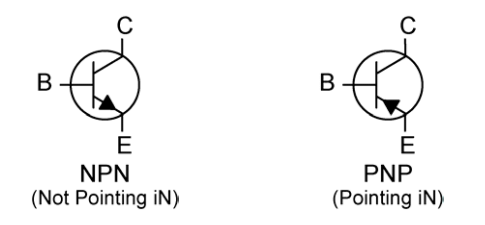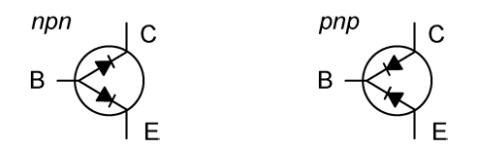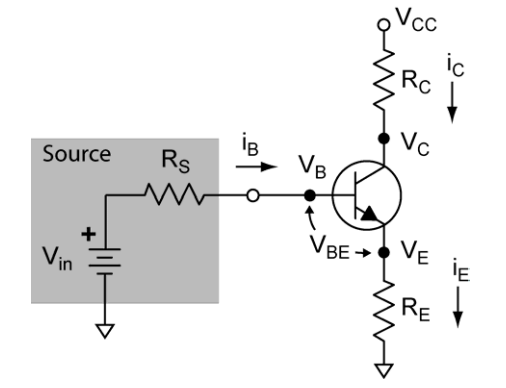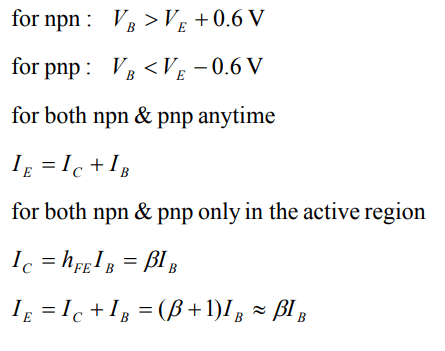BJT & FET - 1 | Electrical Engineering SSC JE (Technical) - Electrical Engineering (EE) PDF Download
The name transistor comes from the phrase “transferring an electrical signal across a resistor.”
In this EduRev document, we will discuss two types of transistors:
- The Bipolar Junction Transistor (BJT) is an active device. In simple terms, it is a current controlled valve. The base current (IB) controls the collector current (IC).
- The Field Effect Transistor (FET) is an active device. In simple terms, it is a voltage-controlled valve. The gate-source voltage (VGS) controls the drain current (ID).
Regions of BJT Operation
- Cut-off region: The transistor is off. There is no conduction between the collector and the emitter. (IB = 0 therefore IC = 0)
- Active region: The transistor is on. The collector current is proportional to and controlled by the base current (IC = βIC) and relatively insensitive to VCE. In this region the transistor can be an amplifier.
- Saturation region: The transistor is on. The collector current varies very little with a change in the base current in the saturation region. The VCE is small, a few tenths of volt. The collector current is strongly dependent on VCE unlike in the active region. It is desirable to operate transistor switches will be in or near the saturation region when in their on state.
Rules for Bipolar Junction Transistors (BJTs)
- For an npn transistor, the voltage at the collector VC must be greater than the voltage at the emitter VE by at least a few tenths of a volt; otherwise, current will not flow through the collector-emitter junction, no matter what the applied voltage at the base.
- For pnp transistors, the emitter voltage must be greater than the collector voltage by a similar amount.
- For the npn transistor, there is a voltage drop from the base to the emitter of 0.6 V. For a pnp transistor, there is also a 0.6 V rise from the base to the emitter. In terms of operation, this means that the base voltage VB of an npn transistor must be at least 0.6 V greater that the emitter voltage VE; otherwise, the transistor will pass an emitter-to-collector current. For a pnp transistor, VB must be at least 0.6 V less than VE; otherwise, it will not pass a collector-to-emitter current.
Basic Equations for BJT
BJT Schematic Symbols (Mnemonics for remembering the direction of the arrows are in
parenthesis.)

Ohmmeters view of the BJT. Clearly a transistor cannot be made on the bench by combining two resistors. (Why is that?) Most ohmmeters can not only measure the resistance, but also measure the forward voltage drop across a diode. From this perspective you can identify the base and the type of transistor based on the following equivalent circuits.

Common Nomenclature (npn example)

Types of Amplifiers
- The transistor is a three-terminal device; thus, the input and the output must share one terminal in common.
- This is the origin of the nomenclature of the three types of transistor amplifiers: common collector, common emitter, and common base.
Definition of Gain
- Gain is defined as the ratio of the output signal to the input signal. Because transistor amplifiers often have a quiescent output (a non-zero output when the input is zero) we define gain as the derivative of the output with respect to the input.
- For systems where the quiescent output is zero, this reduces to the ratio of the output to the input. Thus, gain is defined as the ratio of the change in output to the change in input.
- So far, we have not specified the output quantity, the reason is that we can define the gain with respect to any given output and input quantity.

- Note that a negative gain means that the sign of the signal is inverted. Negative gain is not possible for Power Gain. |A| less than unity indicates that the output is smaller than the input.
- The quantities need not be the same. If the input and output quantities are different, the gain is no longer unitless. The most common examples are transimpedance gain and transadmittance gain.

Input Impedance of a Transistor

- Impedance is defined as Z = V/I. In linear circuits (with resistors, capacitors, inductors, batteries, etc.) this ratio is the reciprocal of the slope of the I versus V graph.
- In circuits with nonlinear elements such as a transistor, the input impedance of the transistor is defined as the reciprocal of the slope of the I versus V graph. This is simply the derivative of Vin with respect to Iin.

- We can easily find Zin from what we know already of the behavior of the transistor. We know that the sum of VBE and the IR drop across RE must equal Vin.

- Taking the derivative of Vin with respect to Iin, remembering that VBE is a constant, we get the result:

- Because IE = IB(β + 1) The IR drop across RE is greater than it would be for IB alone.
- The amplification of the base current causes RE to appear larger to a source looking into the input by (β + 1).
Output Impedance of a Transistor for the Emitter Follower (Common Collector)

The output impedance seen by the load (RE in this example) is defined as:

The minus sign in the derivative comes from the fact the output impedance has the effect of decreasing Vout. The output current Iout is just the emitter current IE which is related to the base current.

Thus we obtain the result that the impedance of the source, as viewed by the load, is reduced by the factor ~1/β.

This topic does not end here. So, to read further the topic of FET, click here

|
23 videos|98 docs|42 tests
|
FAQs on BJT & FET - 1 - Electrical Engineering SSC JE (Technical) - Electrical Engineering (EE)
| 1. What are the different regions of operation for a Bipolar Junction Transistor (BJT)? |  |
| 2. What are the rules for Bipolar Junction Transistors (BJTs)? |  |
| 3. What are the basic equations for a Bipolar Junction Transistor (BJT)? |  |
| 4. What are the different types of amplifiers that can be built using Bipolar Junction Transistors (BJTs)? |  |
| 5. What is the input impedance of a Bipolar Junction Transistor (BJT)? |  |


















